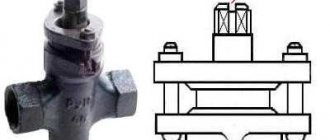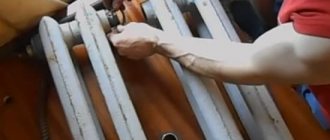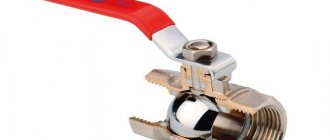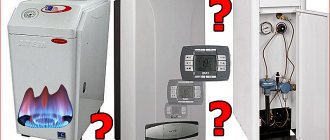What to do with a stuck ball valve
If ball valves are not rotated for years, they tend to sour and jam. In such a situation, do not try to resolve the issue physically and do not force the “butterfly” with pliers or a gas wrench. It is made of a brittle alloy and will probably break. Proceed like this:
- Unscrew the locking nut and remove the butterfly handle from the stem.
- On most of these valves, you will find a nut under the handle that clamps the plastic seal. Loosen it by turning the wrench half a turn. If there is no nut, go to the next step.
- Take an adjustable wrench or other device that allows you to securely grab the flats on the rod. Without applying much force, turn it as far as possible.
- When you feel resistance, turn the rod back all the way and forward again, trying to turn it a few more degrees. Work carefully and without haste!
- In this way, rotate the valve 90°, then tighten the gland nut and reinstall the handle.
An adjustable wrench can be used to firmly grasp the edges
Advice. If you have WD-40 spray lubricant in your household, apply it to the stem and wait 5-10 minutes before rotating.
Be doubly careful when turning off radiators with soured taps during the heating season. If you hurry too much and apply too much force, you will break off the metal rod or ball, and in the worst case, the valve body will burst. A stream of hot water can shoot out from the crack, which can burn you. While you go down to the basement and close the heating riser, the coolant will cause damage to the interior of the room, and you can roughly guess how much it costs to renovate the apartment now.
If you are not sure of your actions, call a plumber. More information on how to close a jammed ball valve in order to disconnect the radiators is described in the video:
Heating Systems Basics
In general, according to the regulations of utility services, it is prohibited to interfere with the operation of the central systems of the house. In exceptional cases, when the battery is leaking or has ruptured, emergency intervention is permitted. But if the heating system in your home is connected to the central system correctly, then you can try turning off the heating yourself. There is nothing particularly difficult about this.
Correct connection means that the heating is connected to the general system using two ball valves (Figure 1) and a jumper called a bypass (Figure 2). This connection is called one-pipe. (Figure 3)
Figure 1 – Two taps
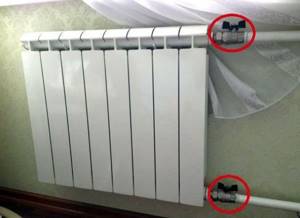
Figure 2 – Bypass jumper
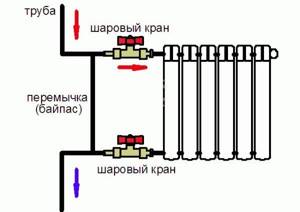
Figure 3 – One-pipe system with a jumper. It can be covered
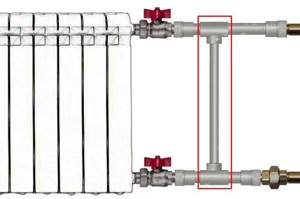
Important Modern heaters are filled with water, which plays the role of a coolant. In winter, hot water flows through the heating pipes, and cold water in summer. Oddly enough, it is filling with water that saves the insides of the radiator from rusting from the inside. After all, if all the water is drained from the heating system, then its remaining drops will create a microclimate for the formation of corrosion.
How to reduce the heating of a radiator?

Adjusting heating radiators in an apartment allows you to simultaneously solve several problems, the main one of which is to reduce the cost of paying for certain utilities.
This possibility is realized in different ways: mechanically and automatically. However, when changing the heating system parameters, the average room temperature does not increase. You can only reduce it to the desired level by adjusting the position of the fittings. It is advisable to install such devices on batteries in houses where it is cool in winter.
Why do you need to make adjustments?
The main factors explaining the need to change the heating level of batteries using locking mechanisms and electronics:
- Free movement of hot water through pipes and inside radiators. Air pockets may form in the heating system. For this reason, the coolant stops heating the batteries, as it gradually cools. As a result, the indoor microclimate becomes less comfortable, and over time the room cools down. To maintain heat in the pipes, shut-off mechanisms installed on radiators are used.
- Adjusting the temperature of the batteries makes it possible to reduce the cost of heating your home. If the rooms are too hot, by changing the position of the valves on the radiators you can reduce costs by 25%. Moreover, reducing the heating temperature of the batteries by 1°C provides savings of 6%.
- In cases where radiators heat up the air in the apartment very much, you have to open the windows often. It is not advisable to do this in winter, because you can catch a cold. To avoid having to constantly open windows in order to normalize the microclimate in the room, regulators should be installed on the batteries.
- It becomes possible to change the heating temperature of radiators at your discretion, and individual parameters are set in each room.
How to regulate radiators
To influence the microclimate in the apartment, you need to reduce the volume of coolant passing through the heating device. In this case, it is only possible to reduce the temperature value. The heating system is adjusted by turning the valve/faucet or changing the parameters of the automation unit. The amount of hot water passing through the pipes and sections is reduced, and at the same time the battery heats up less intensely.
To understand how these phenomena are interconnected, you need to learn more about the operating principle of the heating system, in particular, radiators: hot water entering the heating device heats the metal, which, in turn, releases heat into the air. However, the intensity of heating the room depends not only on the volume of hot water in the battery. The type of metal from which the heating device is made also plays an important role.
Cast iron has a significant mass and releases heat slowly. For this reason, it is not advisable to install regulators on such radiators, since the device will take a long time to cool. Aluminum, steel, copper - all these metals instantly heat up and cool down relatively quickly. Work on installing regulators should be carried out before the start of the heating season, when there is no coolant in the system.
In an apartment building, there is no way to change the average water temperature in the heating system pipes. For this reason, it is better to install regulators that allow you to influence the microclimate in the room in a different way. However, this cannot be realized if the coolant is supplied from top to bottom. In a private house there is access and the ability to change individual equipment parameters and coolant temperature. This means that in this case it is often impractical to mount regulators on batteries.
How to install a thermostat on a battery: step-by-step instructions
- metal-plastic pipe with a diameter of 20 mm;
- 2 tees with 1/2″ thread;
- 6 American metal-plastic compression fittings;
- thermostat;
- ball valve
Unscrew the drive nut with an adjustable wrench and unscrew the old winding.

Clean the threads of the outlet so that the connection between the radiator and the pipe is clearly visible.

Perform the same operation with the lower connection. For ease of installation, remove the radiator and place it on a flat horizontal surface. Hold the radiator cap with one wrench and unscrew the tube with the second.

After this, remove the old seal from the hole, for example, with a screwdriver.

Now you need to assemble a bypass with a thermostat and a ball valve. Coat the threads of the compression fitting with silicone sealant until it fills all cavities.
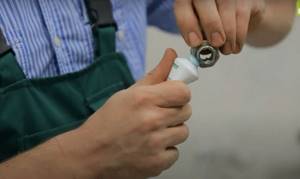
Take 2 tees and 2 nipples and twist them together.

Screw the thermostat and ball valve to the nipple.

Install transition couplings from metal-plastic to metal into the tee. You should end up with a knot like this.

Screw it into the battery.

Do the same with the bottom connection.

For the bypass, cut off a section of metal-plastic pipe of the required length, after first removing the nuts from the compression fittings and measuring the distance.
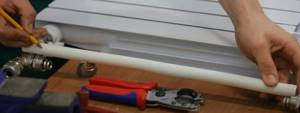
Calibrate the edges, that is, remove the chamfers with a calibrator.

Place the nut and ferrule on the pipe and connect it to the ball valve and thermostat.

Do the same with the other end of the pipe. The jumper (bypass) is ready. Connect it to the radiator.

Hang the battery on the old mount and connect it to the riser. To do this, prepare 2 metal-plastic tubes. Don't forget to measure the length at the top and bottom - it often varies.
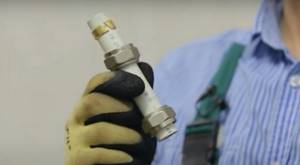
Remove the bypass from the radiator. Screw the tubes into the upper and lower nodes.

Install the bypass on the radiator, and the tubes in the riser outlets. At the top there is a thermostat for heating.
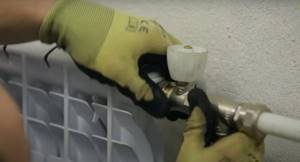
Below is a ball valve.

Tighten the nuts with an adjustable wrench. The radiator with thermostat can be put into operation.
Hell's heat: what to do if your apartment is too hot in winter
What do we usually complain about to city utilities when winter comes into its own?
That's right, most of the complaints relate to heating. Often it becomes too cold in apartments, and we start asking utility companies to do something to make the radiators at least a little hotter. As a result, many residents of Russia for the first time encountered such a problem as “overtopping”. This word refers to a situation where heating network employees work too hard, resulting in the temperature inside apartments exceeding all established standards, causing discomfort among citizens. By the way, the normal temperature in an apartment is 22–24 degrees above zero on the Celsius scale. Fluctuations of plus or minus two degrees are considered acceptable. If the temperature does not meet these standards for quite a long time, you can make a fuss with a clear conscience.
The situation, to put it mildly, is atypical for Russia, and therefore few people know what can be done in such cases. And there can be several exits at once. Which one to choose will depend on the specific situation.
Using a Heat Shield
The heat from the hot battery is transferred in different directions and directions, creating a comfortable environment in the apartment. The use of a special heat shield will not only effectively reduce the excessive temperature of the battery, but also avoid heat leakage, reaching up to 20 percent. A battery placed in a niche releases heat not only into the apartment, but also onto the external wall, actually heating the street.
The heat shield can be installed using a special heat-insulating material placed between the wall and the heating radiator.
This “life hack” will give the heating system several extremely positive qualities:
- providing thermal insulation of walls;
- prevention of excessive heat transfer resulting from differences in street and room temperatures;
- ensuring an effect in which heat from the heating device is reflected into the depths of the room;
- achieving uniform distribution of heat transfer, protection against battery overheating.
We recommend: How to remove cracks and squeaks in laminate flooring without disassembling the floor
Various thermal insulation materials used to create screens have a foil base. A special combination of materials such as polystyrene foam or polyethylene foam with foil can shield thermal energy through good thermal insulation properties. The foil present in this device reflects about 90 percent of the heat, eliminates its loss and helps it to be evenly distributed throughout the room.

Correct procedure
A bypass is a small branch from the common riser in the form of a connecting jumper between pipes. The presence of a bypass will ensure that you are cutting off the battery only in your apartment, and not in the entire house. If your heating system is connected exactly as in the figures above, then in order to shut off the battery you need to use taps. The question arises: should you use the top or bottom tap?
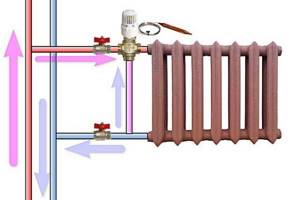
You need to know right away that you don’t need to close two taps! As we already know, hot water flows through the pipes in winter, heating the heater. If you turn off both taps, the temperature of the water inside will drop sharply. It would seem that this is what we need! But at the same time, the volume of water filling the radiator will decrease. And the empty space will be filled by a vacuum, which creates pressure inside.
As a result of excess pressure, the battery may crack or even burst! To painlessly turn off the heating if you are hot, you just need to close the bottom tap. The top one remains open so that the heater is full and does not create a vacuum or air pockets.
That is, your procedure consists of 3 points:
- Feel that you are hot.
- Make sure your system is equipped with valves and a bypass.
- Close the bottom tap, but do not touch the top one.


